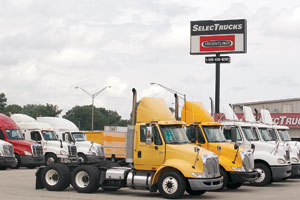Senior Reporter
Used-Truck Prices Dip; Inventories Stabilize

This story appears in the June 6 print edition of Transport Topics.
The price of a used Class 8 truck sold in April fell compared with a year earlier, but inventories stabilized after rising for the past year, analysts said.
The average used-truck price was $44,216, down about 9% compared with $48,042 in 2015, ACT Research Co. said, calling the decline an indication demand remains soft but the market has avoided a cliff-like event. The average age was 85 months, down from 86 a year earlier.
When looked at sequentially, April’s average price was up about 4% from March when the price was $42,698, which itself was an increase of 4% from February, ACT said.
“We haven’t seen 8% of increases in two months since the early 2014 timeframe. I hate to connect two dots and say, ‘Yeah, this is a trend,’ but at least it is progress in the short run if nothing else. I’d say it was the composition of specifications and that sort of thing,” Steve Tam, ACT vice president, commercial vehicle sector, told Transport Topics.
The number of trucks sold in April fell, too.
ACT said 3,098 Class 8 trucks were sold, down about 11% from 3,452 a year earlier. Year-to-date sales of 11,487 were down 3% from 11,833 in 2015. Ginnie Henkels, chief financial officer at Swift Transportation Co., said during a recent earnings call the truckload carrier plans to put 200 trucks on the market this year, including vehicles from all its segments as truck utilization remains a concern.
“The weakness in the freight market is a frustration for drivers … this is one of the reasons we have reduced the fleet. We want to ensure we are getting as many miles as possible to keep our current drivers, and to keep them happy,” Henkels said late last month.”
At Knight Transportation, the addition of advanced driver assistance technologies and automated transmissions on trucks is leading to a longer replacement timeframe, CEO Dave Jackson said.
“We may need to hold on to equipment a little bit longer to get our return out of that,” he said on an earnings call.
Phoenix-based Swift ranks No.6 on the Transport Topics Top 100 list of the largest U.S. and Canadian for-hire carriers. Knight, also based in Phoenix, ranks No. 31.
Inventory was at a turning point, Tam said.
“The comments that inventory is bad or getting worse seem to be waning. I am not sure we have started to make any meaningful reductions at this point, but at least we stemmed the tide,” Tam said.
He added, inventories started to rise “in April or May of last year as a result of increasing new truck sales.”
ACT surveys dealers, wholesalers and auctioneers, as well as a few large fleets, to determine average prices, age and mileage.
Neil Frohnapple, an analyst with Longbow Research, surveyed International Truck dealers, and a majority cited improved inventory levels.
Only 45% of contacts reported above ideal used-truck inventory versus 85% that were too high in prior checks, Frohnapple wrote in a note to investors late last month.
Dealers told him the declines in used-truck values also were less severe thus far in the second quarter compared with the steeper decreases that occurred in the second half of 2015 and the first quarter of 2016.
International is a unit of Navistar International Corp., based in Lisle, Illinois.
Tam said the average mileage in April fell to 482,713 from 498,342 a year earlier.
Meanwhile, Chris Visser, senior analyst for commercial vehicles, NADA Used Car Guide, said April’s key points were the volume of trucks moving through auction was “notably lower,” depreciation at the retail level “moderated” into the second quarter and retail traffic was “incrementally” higher.
Also, the number of 3- to 5-year-old sleeper tractors sold at auction fell substantially in April, a development also evident in the dealer-to-dealer channel, with 44% fewer trucks of that age range reported sold, Visser said.
As a result, the average age of trucks sold in the overall wholesale universe jumped to 93 months in April, which was 11 months higher than March, Visser said.
Year-to-date, 3- to 5-year-old sleepers are bringing $8,626, or 15.9% less money than in the first four months of 2015, with 4-year-old trucks suffering the worst, he said.“Most dealers have more than enough inventory of late-model sleepers,” Visser said, “so activity in the nonauction wholesale channel is likely centered around inventory relocation and specific needs from customers.”

